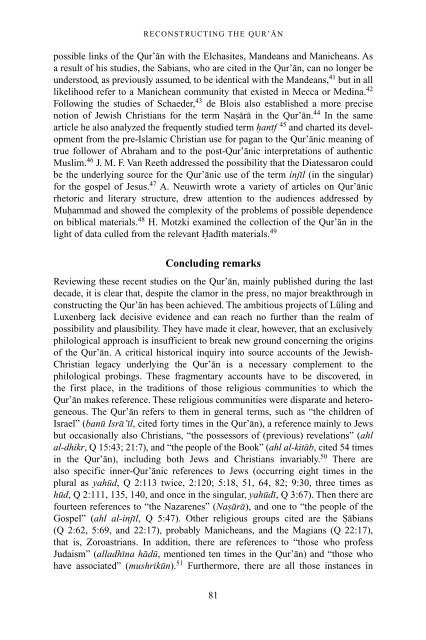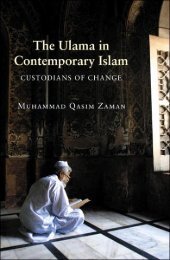The Qur'an in its historical context (pdf - Islam and Christian-Muslim ...
The Qur'an in its historical context (pdf - Islam and Christian-Muslim ...
The Qur'an in its historical context (pdf - Islam and Christian-Muslim ...
You also want an ePaper? Increase the reach of your titles
YUMPU automatically turns print PDFs into web optimized ePapers that Google loves.
RECONSTRUCTING THE QUR’AN<br />
possible l<strong>in</strong>ks of the Qur’an with the Elchasites, M<strong>and</strong>eans <strong>and</strong> Manicheans. As<br />
a result of his studies, the Sabians, who are cited <strong>in</strong> the Qur’an, can no longer be<br />
understood, as previously assumed, to be identical with the M<strong>and</strong>eans, 41 but <strong>in</strong> all<br />
likelihood refer to a Manichean community that existed <strong>in</strong> Mecca or Med<strong>in</strong>a. 42<br />
Follow<strong>in</strong>g the studies of Schaeder, 43 de Blois also established a more precise<br />
notion of Jewish <strong>Christian</strong>s for the term Nasara <strong>in</strong> the Qur’an. 44 In the same<br />
article he also analyzed the frequently studied term hanif 45 <strong>and</strong> charted <strong>its</strong> development<br />
from the pre-<strong>Islam</strong>ic <strong>Christian</strong> use for pagan to the Qur’anic mean<strong>in</strong>g of<br />
true follower of Abraham <strong>and</strong> to the post-Qur’anic <strong>in</strong>terpretations of authentic<br />
<strong>Muslim</strong>. 46 J. M. F. Van Reeth addressed the possibility that the Diatessaron could<br />
be the underly<strong>in</strong>g source for the Qur’anic use of the term <strong>in</strong>jil (<strong>in</strong> the s<strong>in</strong>gular)<br />
for the gospel of Jesus. 47 A. Neuwirth wrote a variety of articles on Qur’anic<br />
rhetoric <strong>and</strong> literary structure, drew attention to the audiences addressed by<br />
Muhammad <strong>and</strong> showed the complexity of the problems of possible dependence<br />
on biblical materials. 48 H. Motzki exam<strong>in</strong>ed the collection of the Qur’an <strong>in</strong> the<br />
light of data culled from the relevant Hadith materials. 49<br />
Conclud<strong>in</strong>g remarks<br />
Review<strong>in</strong>g these recent studies on the Qur’an, ma<strong>in</strong>ly published dur<strong>in</strong>g the last<br />
decade, it is clear that, despite the clamor <strong>in</strong> the press, no major breakthrough <strong>in</strong><br />
construct<strong>in</strong>g the Qur’an has been achieved. <strong>The</strong> ambitious projects of Lül<strong>in</strong>g <strong>and</strong><br />
Luxenberg lack decisive evidence <strong>and</strong> can reach no further than the realm of<br />
possibility <strong>and</strong> plausibility. <strong>The</strong>y have made it clear, however, that an exclusively<br />
philological approach is <strong>in</strong>sufficient to break new ground concern<strong>in</strong>g the orig<strong>in</strong>s<br />
of the Qur’an. A critical <strong>historical</strong> <strong>in</strong>quiry <strong>in</strong>to source accounts of the Jewish-<br />
<strong>Christian</strong> legacy underly<strong>in</strong>g the Qur’an is a necessary complement to the<br />
philological prob<strong>in</strong>gs. <strong>The</strong>se fragmentary accounts have to be discovered, <strong>in</strong><br />
the first place, <strong>in</strong> the traditions of those religious communities to which the<br />
Qur’an makes reference. <strong>The</strong>se religious communities were disparate <strong>and</strong> heterogeneous.<br />
<strong>The</strong> Qur’an refers to them <strong>in</strong> general terms, such as “the children of<br />
Israel” (banu Isra’il, cited forty times <strong>in</strong> the Qur’an), a reference ma<strong>in</strong>ly to Jews<br />
but occasionally also <strong>Christian</strong>s, “the possessors of (previous) revelations” (ahl<br />
al-dhikr, Q 15:43; 21:7), <strong>and</strong> “the people of the Book” (ahl al-kitab, cited 54 times<br />
<strong>in</strong> the Qur’an), <strong>in</strong>clud<strong>in</strong>g both Jews <strong>and</strong> <strong>Christian</strong>s <strong>in</strong>variably. 50 <strong>The</strong>re are<br />
also specific <strong>in</strong>ner-Qur’anic references to Jews (occurr<strong>in</strong>g eight times <strong>in</strong> the<br />
plural as yahud, Q 2:113 twice, 2:120; 5:18, 51, 64, 82; 9:30, three times as<br />
hud, Q 2:111, 135, 140, <strong>and</strong> once <strong>in</strong> the s<strong>in</strong>gular, yahudi, Q 3:67). <strong>The</strong>n there are<br />
fourteen references to “the Nazarenes” (Nasara), <strong>and</strong> one to “the people of the<br />
Gospel” (ahl al-<strong>in</strong>jil, Q 5:47). Other religious groups cited are the Sabians<br />
(Q 2:62, 5:69, <strong>and</strong> 22:17), probably Manicheans, <strong>and</strong> the Magians (Q 22:17),<br />
that is, Zoroastrians. In addition, there are references to “those who profess<br />
Judaism” (alladh<strong>in</strong>a hadu, mentioned ten times <strong>in</strong> the Qur’an) <strong>and</strong> “those who<br />
have associated” (mushrikun). 51 Furthermore, there are all those <strong>in</strong>stances <strong>in</strong><br />
81



